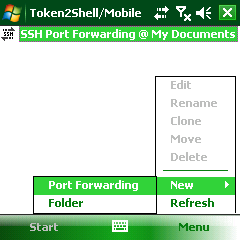
- #WINDOWS MOBILE SSH TUNNEL HOW TO#
- #WINDOWS MOBILE SSH TUNNEL PRO#
- #WINDOWS MOBILE SSH TUNNEL WINDOWS#
It can also be used to implement VPNs (Virtual Private Networks) and access intranet services across firewalls. SSH Tunnel allows a network user to access or provide a network service that the underlying network does not support or provide directly. It can be used to add encryption to legacy applications. On the other hand, SSH tunneling/port forwarding is a mechanism that creates a secure SSH connection between a local and remote computer.

#WINDOWS MOBILE SSH TUNNEL HOW TO#
putty -L 7456::7456 -ssh A.B.C.D:8080Īlso if you actually want to know how to use the GUI for setting up a tunnel, that's in section 4.25 called The Tunnels panel. SSH tunneling is a method of transporting arbitrary networking data over an encrypted SSH connection. Plink mysession -R 5023::23īased on your example, the command line would be something like this. To forward a remote port to a local destination, just use the -R option instead of -L: Creating an ssh tunnel from remote machine to office linux machine Open putty Under Category go to Connection, SSH, Tunnels.
#WINDOWS MOBILE SSH TUNNEL PRO#
Used the free version for over a month and bought pro version for port forwarding. To forward a local port (say 5110) to a remote destination (say port 110), you can write something like one of these: to build the best mobile SSH client possible. The command-line options work just like the ones in Unix ssh programs. From the manual:Īs well as setting up port forwardings in the PuTTY configuration (see section 4.25), you can also set up forwardings on the command line. Specifically, section 3.8.3.5 is all about port forwarding. In it, there's a whole section called The PuTTY command line within the section called Using PuTTY. The Help button in the screenshot you posted will open the PuTTY User Manual.
#WINDOWS MOBILE SSH TUNNEL WINDOWS#
I actually prefer to just launch it from the Windows Run dialog or a powershell/cmd prompt most of the time. Ssh -T -L50000:localhost:23 my. don't need to use the GUI to initiate a PuTTY connection. The steps above are represented as the following command on the QP2TERM/QP2SHELL/QSH command line: The steps above are represented as the following command on a UNIX system: Here, we use the port 8080 as the local proxy port. Second, set the dynamic port forwarding as in the following figure. You can input the host only and PuTTY will ask for the username. You can tunnel multiple ports if you like however, all require that the PuTTY secure shell connection stays active for data to pass over the tunnel to the remote server. First, input the username and host name as in the following figure.

You should get the remote sign on screen of the system you are tunneling to. Your task is to connect to the Windows Server using the RDP client. All other ports are blocked by a hardware firewall or Windows Firewall. For example, you have a Windows Server with only SSH port open (TCP 22). Configure a new connection and use the parameters below:Ĭlick on Communications, and connect. SSH tunneling is mostly used in the scenarios when you need to connect to a remote computer behind the firewall. After you are signed in, you must leave this window open to keep your tunnel active. Now you can launch your session and sign in to the secure shell. In the left pane, click on Session to bring up the following window. Select both Local ports accept connections from other hosts and Remote ports do the same.Ĭlick the Add button to place your tunnel configuration in the Forwarded ports window. localhost:23 will get you a Telnet connection. The Destination is the connection on your remote SSH machine. In the Port forwarding section, the Source Port is the source TCP/IP address you want assigned to your local host connection.

Do not save this yet we have to configure the ports for tunneling.Ĭlick on the path to reach Tunnels ( Connection > SSH >Tunnels): SSH tunneling, also known as SSH port forwarding, is how SSH tunnels network traffic through application ports from the localhost - the computer physically. All of this rerouted traffic is securely encrypted as it travels between your local machine and the remote server thanks to SSH. Type the name you wish to use for the saved connection. An SSH tunnel is another method of rerouting some or all traffic from one location (like your local computer) through another (your remote server). Open PuTTY.EXE, configure your host name, and select SSH for port. To configure a PuTTY session for tunneling Telnet traffic, do the following: Enter the following, replacing the target computer and your username excluding parentheses and/or square brackets.


 0 kommentar(er)
0 kommentar(er)
